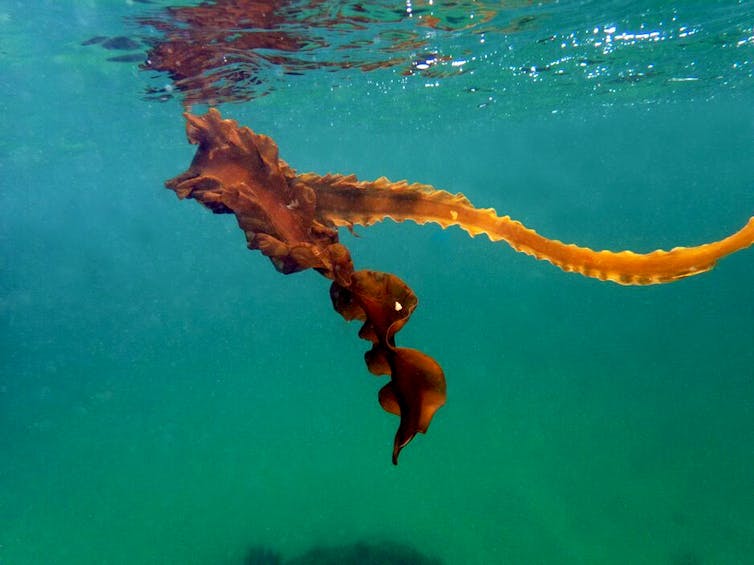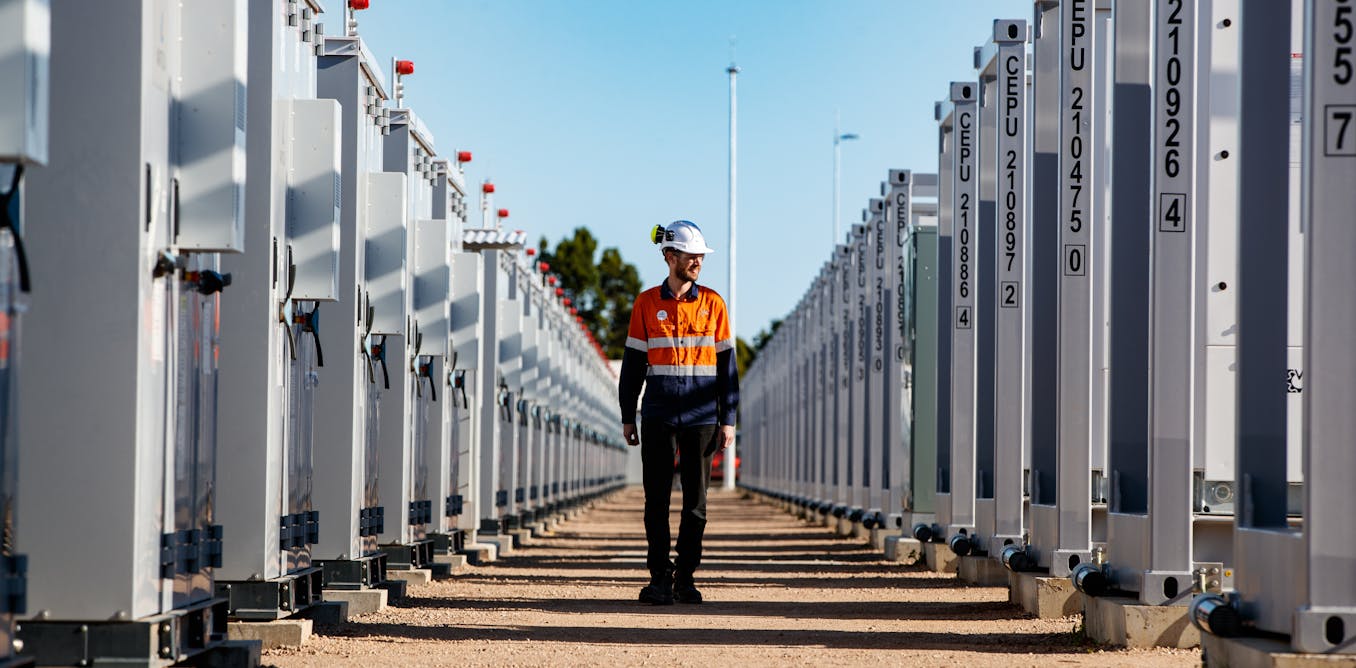Countries around the world are increasingly turning to nature to help alleviate the impacts of climate change. Forests, grasslands and wetlands are already considered as “natural climate solutions.” Now, some scientists are asking: could kelp forests be part of the solution too?
As some of the fastest growing species on Earth, kelp form lush underwater forests along temperate coastlines. In addition to supporting marine biodiversity, sustaining fisheries and contributing to local economics and livelihoods, kelp forests also absorb carbon. But their role in climate change mitigation remains uncertain.
In the first national assessment of Canada’s kelp forests, our research team set out to estimate how much carbon these ecosystems might be capturing and storing in the ocean, and whether that carbon stays out of the atmosphere long enough to be considered a natural climate solution.
To tackle this question, we assembled a national kelp forest database, including satellite and aerial maps, kelp productivity measurements and ocean current models to estimate how much kelp carbon actually leaves the continental shelf.
This study is part of a national research effort being led by researchers at the University of Victoria called Blue Carbon Canada, which was funded by Fisheries and Oceans Canada (DFO), Oceans North and the Natural Sciences and Engineering Research Council of Canada (NSERC) to investigate how Canada’s “blue carbon” could fit into its national climate mitigation strategy. Our team included 22 kelp researchers and experts from 14 academic institutions, government agencies and NGOs from Canada, the United States and Australia.
(Matthew Csordas/University of Victoria), Author provided (no reuse)
Read more:
Why some of British Columbia’s kelp forests are in more danger than others
Measuring kelp carbon
The carbon absorbed by trees, peatlands and seagrasses typically gets locked away for decades or longer. However, when kelp dies or breaks apart, instead of storing the carbon in the ground, much of it is released back into the ocean. Depending on the conditions, some of it sinks. Some of it washes back to shore. Some gets eaten and and fuels coastal food webs.
Only a small fraction settles in coastal seafloor sediments or makes it far enough offshore to reach deep water, where it’s more likely to stay out of the atmosphere over the long term. Another fraction decomposes and becomes tiny dissolved particles that can circulate on ocean currents below the mixed layer depth for decades to centuries.
So while protecting and managing kelp forests promotes carbon capture, it may not always directly translate into climate change mitigation.
Our research found that between 40,000 and 400,000 metric tonnes of carbon per year is likely being captured and exported from Canadian kelp forests to the deep ocean. In terms of carbon dioxide removal, this would be at least comparable to more established natural climate solutions carbon ecosystems in Canada, like tidal marshes and seagrasses, suggesting they merit further consideration.
It’s a promising number. But the potential role of kelp in Canada’s climate action plans is far from settled.

(Teigan Labor/Dalhousie University), Author provided (no reuse)
Can we count on kelp?
Our findings are relevant as countries increasingly look to count natural sources of carbon removal in their nationally determined contributions under the Paris Climate Accord, with the idea that better ecosystem management, protection and restoration could all enhance natural carbon sinks.
Kelp forests have not yet been included in national inventories. However, there has been growing interest in whether better kelp forest management and even restoration could qualify.
Part of the problem is data. Most countries, including Canada, still lack sufficient information on where their kelp forests are, how productive they are, where that carbon is going in the ecosystem and how these dynamics are changing over space and time. As a result, few countries have been able to assess their kelp forests at national scales.
There are also unanswered questions about how much kelp forest loss can be prevented under climate change and how much ecosystem restoration could be scaled up to meaningfully contribute to climate change mitigation. Restoration methods for kelp forests, such as green gravel, are being actively developed but remain largely untested.
Our study provides guidance to help countries overcome some of these challenges. We offer a step-by-step blueprint for developing first kelp carbon estimates from limited data, including data needs and sources and tools for data analysis that acknowledge data uncertainties.

(Alexis Savard-Drouin/Dalhousie University), Author provided (no reuse)
Looking ahead
Managing and protecting kelp forests is likely to be a low-regret option, meaning that while it might not significantly mitigate climate change, its many other benefits would still outweigh the costs. After all, these ecosystems offer a host of benefits, from supporting fisheries to shoreline protection. Given our findings, they may also have the ability to help tackle climate change.
But leaning too heavily on kelp before the science is clear could backfire. Overstating its role in climate change mitigation could lead to misplaced confidence and unrealistic expectations. Worse, it could distract from the most important and immediate task: fossil fuel reductions.
That does not mean kelp’s climate solutions potential should be dismissed. At present, it’s thought that kelp forests and other algae capture and store around 175 million tonnes annually, maybe more given recent research.
But Canada needs to proceed carefully and invest in closing key knowledge gaps before scaling up plans to include kelp in national carbon accounting. This includes greater public investment in kelp forest mapping, monitoring, high resolution oceanographic modelling and ground-truthing of national estimates.
Read more:
Buried kelp: seaweed carried to the deep sea stores more carbon than we thought
Kelp forests are in trouble
Overall, a precautionary approach is needed to ensure we don’t miss out on future kelp solutions. That’s because even as interest in kelp grows, these ecosystems are disappearing in many places.

(Lauren Dykman/University of Victoria)
In British Columbia, kelp forests have declined in recent decades due to climate change-fuelled marine heatwaves and population booms of sea urchins, which graze on kelp.
Similar trends have been documented in many parts of the world, from Norway to Tasmania, where lush kelp forests are being replaced by weedy turf algae.
When kelp forests are lost, the carbon they hold can be released quickly. Export of kelp carbon to the deep ocean and other carbon sinks stops. So instead of helping to slow climate change, their loss could make things much worse.
Kelp forests will not solve the climate crisis on their own. But our research shows they could be apart of the solution, especially if we act now to fill critical research gaps.
Today, the most immediate value of kelp forests lies in supporting marine biodiversity, coastal fisheries, and community livelihoods. That alone makes them worth saving.

The post “Can kelp forests help tackle climate change?” by Jennifer McHenry, Senior Research Fellow, Department of Biology, University of Victoria was published on 06/03/2025 by theconversation.com



































Leave a Reply